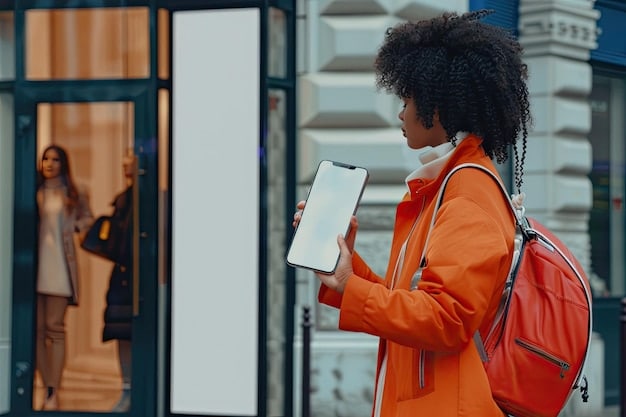Mobile-First E-commerce: Optimizing Marketing for US Shoppers

Mobile-first e-commerce involves optimizing your online store and digital marketing strategies to cater primarily to mobile users due to the increasing prevalence of mobile shopping among the 70% of US consumers who prefer using their smartphones for online purchases.
In today’s digital landscape, a mobile-first e-commerce strategy is no longer optional; it’s essential. With approximately 70% of US shoppers now preferring to make purchases on their mobile devices, businesses must prioritize the mobile experience to stay competitive and maximize their reach. Are you ready to optimize your digital marketing for this significant shift?
Understanding the Mobile-First Revolution in E-commerce
The shift towards mobile-first e-commerce isn’t just a trend; it’s a fundamental change in how consumers interact with online businesses. Understanding the drivers behind this revolution is crucial for any brand looking to thrive in the modern market.
Consumers are now more reliant on their smartphones than ever before. They use them to browse products, compare prices, read reviews, and ultimately, make purchases. This behavior necessitates a mobile-centric strategy for e-commerce businesses.
The Rise of Mobile Shopping
Mobile shopping isn’t just a convenience; it’s becoming the primary method of online shopping for a large segment of the US population. Here are some key factors driving this shift:
- Accessibility: Smartphones provide instant access to online stores anytime, anywhere.
- Convenience: Mobile shopping allows customers to browse and buy products during commutes, breaks, or even while watching TV.
- User Experience: Improved mobile websites and apps offer seamless shopping experiences, with easy navigation and secure payment options.
The Impact on Digital Marketing
The mobile-first revolution has profound implications for digital marketing strategies. Traditional desktop-focused campaigns may no longer be effective in reaching a mobile-dominant audience. Businesses need to adapt their marketing efforts to cater specifically to mobile users. This includes optimizing websites for mobile devices, creating mobile-friendly content, and leveraging mobile advertising channels.
In conclusion, understanding the mobile-first e-commerce revolution is about recognizing the fundamental change in consumer behavior and adapting digital marketing strategies accordingly. Businesses that embrace this shift are more likely to capture a larger share of the mobile market and ultimately drive growth.
Optimizing Your E-commerce Website for Mobile Devices
Having a mobile-friendly website is the foundation of any successful mobile-first e-commerce strategy. This involves ensuring that your website is responsive, fast, and provides a seamless user experience on smaller screens.
Creating a website that adapts to different screen sizes and resolutions is crucial for engaging with mobile shoppers effectively.

Responsive Design Principles
Responsive design is the approach of building a website that adapts to various screen sizes and devices. Here’s how you can implement it effectively:
- Flexible Layouts: Use CSS grid and flexbox to create layouts that automatically adjust to different screen sizes.
- Scalable Images: Optimize images for mobile devices to reduce loading times without sacrificing quality.
- Touch-Friendly Navigation: Design navigation menus that are easy to use on touchscreens, with buttons and links that are large enough to tap accurately.
Page Load Speed Optimization
Mobile users expect websites to load quickly. Slow loading times can lead to high bounce rates and lost sales. Here are some tips to optimize your website’s loading speed:
- Minimize HTTP Requests: Reduce the number of elements on each page to decrease the number of requests to the server.
- Compress Images: Use image compression tools to reduce file sizes without compromising quality.
- Leverage Browser Caching: Enable browser caching to store static content locally, reducing the need to download it on subsequent visits.
Optimizing your e-commerce website for mobile devices through responsive design and speed enhancements is vital for enhancing user engagement and conversion rates. This customer-centric approach helps capture and retain the growing base of mobile shoppers.
Leveraging Mobile SEO for Increased Visibility
Mobile SEO is the practice of optimizing your website to rank higher in mobile search results. With more searches happening on mobile devices, it’s essential to ensure your e-commerce site is visible to mobile users.
To boost visibility on mobile search, focus on localized SEO tactics, mobile-friendly content, and speed optimization.
Importance of Local SEO
Local SEO is crucial for businesses that serve local customers. Here’s how to optimize for local mobile searches:
- Google My Business: Claim and optimize your Google My Business listing with accurate information and engaging content.
- Local Keywords: Incorporate location-specific keywords into your website content and meta descriptions.
- Mobile-Friendly Content: Create content that addresses the needs and interests of local mobile users.
Mobile-Friendly Content Strategies
Creating content specifically tailored for mobile users can significantly improve engagement and rankings. Consider these strategies:
- Short Paragraphs: Break up text into short, readable paragraphs for easier consumption on small screens.
- Visual Content: Use high-quality images and videos to capture attention and enhance the user experience.
- Clear Calls-to-Action: Make sure your calls-to-action are prominent and easy to tap on mobile devices.
By leveraging mobile SEO strategies, businesses can significantly improve their visibility in mobile search results, driving more traffic and sales. This includes prioritizing local SEO and creating mobile-friendly content that caters to the preferences and needs of mobile users.
Mobile Advertising: Reaching Shoppers on the Go
Mobile advertising allows you to target potential customers while they are on their smartphones. With the right strategies, mobile-first e-commerce businesses can reach shoppers at the right place and time.
Mobile advertising facilitates targeted outreach, enabling brands to connect with consumers effectively through channels like social media and location-based ads.
Social Media Advertising
Social media platforms offer powerful targeting options for reaching mobile shoppers. Consider these strategies:
- Targeted Ads: Use demographic, interest-based, and behavioral targeting to reach specific segments of your audience.
- Mobile-Optimized Creatives: Create ads that are visually appealing and optimized for mobile devices, with clear messaging and calls-to-action.
- Retargeting: Retarget users who have previously interacted with your website or ads to encourage them to make a purchase.
Location-Based Advertising
Location-based advertising allows you to target customers based on their physical location. Here’s how to leverage it effectively:
- Geofencing: Set up virtual boundaries around specific locations (e.g., competitor stores) to target customers who enter those areas.
- Local Search Ads: Use Google Ads to target local search queries, ensuring your business appears prominently in local search results.
- Mobile Coupons: Offer mobile coupons and discounts to incentivize nearby customers to visit your store or make a purchase.

Effectively leveraging mobile advertising, especially through social media and location-based strategies, helps businesses reach potential customers on the go. This approach maximizes relevance and engagement, driving conversions and enhancing the overall customer experience.
Personalization and Mobile E-commerce
Personalization is key to providing a great mobile shopping experience. By tailoring the experience to individual users, you can increase engagement and drive conversions.
Customizing the mobile shopping experience based on user data enhances customer satisfaction and encourages repeat business.
Personalized Product Recommendations
Offering personalized product recommendations can significantly boost sales. Here’s how to implement it:
- Data Analysis: Analyze user data (e.g., browsing history, purchase history) to identify patterns and preferences.
- Recommendation Engines: Use recommendation engines to suggest products that users are likely to be interested in.
- Dynamic Content: Display personalized product recommendations on your homepage, product pages, and checkout page.
Customized User Experience
Tailoring the user experience based on individual preferences can enhance satisfaction and loyalty. Consider these approaches:
- Personalized Content: Display content (e.g., articles, videos) that is relevant to each user’s interests.
- Adaptive Layouts: Adjust the layout and design of your website based on the user’s device and screen size.
- Preferred Language and Currency: Allow users to set their preferred language and currency for a more personalized shopping experience.
Incorporating personalization strategies in mobile e-commerce through personalized product recommendations and custom user experiences enhances customer engagement and drives sales. By tailoring the experience to individual preferences, businesses can foster stronger customer relationships and increase loyalty.
The Future of Mobile-First E-commerce: Trends to Watch
The world of mobile-first e-commerce is constantly evolving, with new trends and technologies emerging all the time. Staying ahead of the curve is crucial for maintaining a competitive edge.
Keeping up with emerging trends, like advancements in mobile payments and augmented reality, is essential for staying competitive in the evolving mobile e-commerce landscape.
Mobile Wallets and Payments
Mobile wallets and payment solutions are becoming increasingly popular among mobile shoppers. Here’s what to watch for:
- Seamless Checkout: Implement mobile payment options like Apple Pay, Google Pay, and Samsung Pay for a frictionless checkout experience.
- Biometric Authentication: Use biometric authentication methods (e.g., fingerprint, facial recognition) to enhance security and convenience.
- One-Click Payments: Offer one-click payment options to streamline the purchase process and reduce cart abandonment.
Augmented Reality (AR) Shopping
Augmented reality is transforming the way people shop on their mobile devices. Consider these applications:
- Virtual Try-On: Allow customers to virtually try on clothing, accessories, and makeup using AR technology.
- Product Visualization: Enable customers to visualize products in their own homes or environments using AR.
- Interactive Product Demos: Offer interactive product demonstrations that allow customers to explore product features and benefits in a virtual setting.
Remaining attuned to and adopting future trends in mobile-first e-commerce, such as mobile wallets, seamless payments, and augmented reality shopping experiences, will empower businesses to not only meet but exceed consumer expectations. This proactive approach will drive innovation and ensure a continued competitive advantage.
| Key Point | Brief Description |
|---|---|
| 📱 Mobile Optimization | Ensure your website offers seamless mobile experience. |
| 🚀 Page Speed | Optimize load times to prevent bounce rates. |
| 📍 Local SEO | Improve visibility for local mobile searches. |
| 🛒 Personalization | Enhance user experience with personalized recommendations. |
FAQ
▼
Mobile-first e-commerce is crucial due to the increasing number of consumers using smartphones for online shopping. Optimizing for mobile ensures a better user experience, leading to higher engagement and sales conversion rates.
▼
To improve your mobile website’s speed, compress images, minimize HTTP requests, leverage browser caching, and use a content delivery network (CDN). Regular speed testing helps identify areas that need optimization.
▼
Local SEO helps businesses connect with local customers searching on mobile devices. Optimizing your Google My Business listing and using local keywords can improve your visibility in local search results.
▼
Personalization improves mobile shopping experiences by providing tailored product recommendations and customized content based on user behavior and preferences. This can lead to increased customer satisfaction and loyalty.
▼
Future trends include the use of mobile wallets for seamless payments, augmented reality (AR) for virtual try-ons, and biometric authentication for enhanced security. Keeping up with these trends is crucial for competitiveness.
Conclusion
In conclusion, embracing a **mobile-first e-commerce** strategy is vital for businesses aiming to thrive in today’s digital market. By prioritizing mobile optimization, leveraging mobile SEO, personalizing user experiences, and staying ahead of emerging trends, e-commerce businesses can effectively engage the 70% of US shoppers who prefer using mobile devices. The blend of these elements not only improves the shopping experience but also drives significant growth and boosts overall customer satisfaction.





